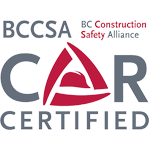Trusted to move the most delicate of homes Since 1945
Frequently Asked Questions About House Moving
If your question is not answered here, please contact us
Why move a house?
It’s cheaper than new construction and often has better material and workmanship. It may also have sentimental (old family home?) or heritage value. From a developer’s point of view, he/she may save $5,000 to $10,000 in demolition costs by saving the house. If a property is subdividable, typically the original house will straddle proposed new property lines. Simply moving the house over a few feet and constructing a new foundation will free up a spare lot to help pay down the mortgage or allow you to move on another house or construct a new one.
Is there any type of house that cannot be moved?
No, anything can be moved. Financial/value concerns limit the viability of any project. Typically, a wood frame house on a crawlspace or basement that was built to the building code of its day, and is in reasonable condition, is worth moving. Wood framed houses constructed on slabs, brick buildings, steel buildings, etc. are movable also, but each one has to be looked on its own merits. Cities and municipalities often demand that certain heritage buildings on a site be moved and restored as part of the development package. These projects often exceed the value of new construction, but the cities and municipalities give developers concessions (higher density, less parking requirements, reduced setbacks, etc.) to offset the extra costs associated with this.
Where do we operate?
We primarily cover southwestern BC. If the project is large enough we can be competitive throughout all of BC.
How far can we move a building?
Provincial Highway Regulations allow us to transport a house on their highways a maximum of 100 KM. In exceptional cases this can be exceeded, but they will judge it on a case by case basis (i.e. if the nearest next town is 150 KM away). In most areas, we are only allowed on the roads between 2 AM and 5 AM, so we are limited by time as well, although we can spread the move over several nights, if necessary. In BC, you will be hard pressed to move a house on the highways much more than that without encountering low overpasses or covered bridges that the house won’t fit under.
If access to the waterways of BC is possible, we can put the house on a barge and travel vast distances. A lot of houses get moved out of the Vancouver/Lower Mainland area to further up the Fraser River (at certain times of year as far up as Hope), to Gulf Islands, Sunshine Coast, Vancouver Island, or anywhere else on the coast that has water access.
Do I need any permits, and how long does this take?
Before the house can be removed from its existing location a demolition/move off permit must be obtained. This is usually arranged by and paid for by the person that owns the property as it involves costs of disconnecting services (i.e. sewer, water, power, gas, etc.) If the new site is in an area that is not serviced by sewer, you will require a Health Permit to construct a sewage disposal system. This process can take a month or more. Next you will require a Building Permit for the new site. This can also take a month or more. In both cases, if you hire contractors that are familiar with local requirements and their inspectors, the time can be reduced considerably. The local building inspector will likely either want to inspect the house prior to moving or have you provide an engineer’s report that certifies that the building was constructed to the code of its day and that the roof structure meets the snow loading requirements of the new area. Some building inspectors erroneously will tell you that the house must be brought up to current codes (i.e. replacing windows, increasing insulation in the walls and ceilings, making hallways wider, etc.). This is not so, the National Building Code has specific mention on this issue and have produced a handbook of interpretations that include this. Ask Peter
The exception to this is life/safety issues (i.e. floor joist spans, electrical, plumbing, etc.)
What kind of prep work do I have to do before moving my house?
Any exterior additions that are not to be moved (i.e. decks, additions, lean-tos, etc.) must be removed. Any brickwork/chimneys that are not to be moved must be removed. All services must be disconnected. Demolition/Move off permit must be obtained. If the house is on a basement, this must be stripped out to bare studs and floor joists leaving exterior sheathing intact for stability. All serviceable items in the basement (furnace, hot water tank, doors and frames, basement windows, ducting, etc.) can be salvaged and placed upstairs. We will require reasonable access for our equipment and for egress of the house. This may require removal of trees or other landscaping.
Do houses ever get damaged while being moved or raised?
In the case of drywalled houses, you may experience a few stress cracks in the drywall, especially over doorways (but no more than you will see in an average new house that settles). Lath and plaster houses will likely show more. The new foundation that you or your contractor construct will not be exactly the same as the original and the house will slowly settle accordingly. The remedial work is minimal, but you may have to adjust some doors as well. No structural damage will occur.
How much does it cost to raise or move a house?
Every project is different. There are so many different factors that affect the cost. Each project is priced based on the amount of equipment and amount of crew time required.
Does weather play a factor in raising my house?
No it does not. If you intend to live in the house while it is raised, the floors can become very cold as the wind is free to flow through the basement.
How high can a house be raised?
Every area has zoning rules that dictate the maximum allowable height and square foot coverage on the lot. Check with your planning department at city hall. Generally, if your roofline is lower than your entire neighbour’s’, you should not have any problems.
Do I need a permit to raise my house?
Yes, you need a building permit. As with moving a house, the original structure is “existing” and need not be modified. Only the new basement construction must meet current building codes, except for life/safety concerns.
What kind of prep work do I need to do before raising my house?
The basement needs to be stripped out to bare studs and joists. Typically, if you have overhead services, these need not be disconnected. Furnace, hot water tank, gas, sewer, and water need disconnected. Any brickwork not being raised needs to be removed. Any porches or leantos that aren’t being raised should be removed.
How long does it take to raise my house?
Most houses can be raised in one day. We allow it to sit on our equipment for 30 days to allow you to frame in the basement, then we return to lower it and remove our equipment.
Can I live in my house while it is raised.
Yes you can. You will need to make some temporary external stairs and hook up the various services using flexible connections.
Do I need extra insurance while my house is being moved or raised?
We insure your house while it is on our equipment for a maximum of 30 days. Consult with your agent to ensure that your other coverages are adequate.
Our House Moving & Lifting Services
- House
Relocating / Moving - House
Lifting / Raising - City to City
Transporting - Property Moves
Same Lot Moves - Cottage
Moving - Heritage Home
Relocating - Construction
Trailer Moving






